Did you know you can create a small habitat of Florida’s native plants – even if you live in a patio home, apartment or condo? By planting native plants in containers, you too can enjoy the presence of small birds, butterflies and other native pollinators who will visit your garden space!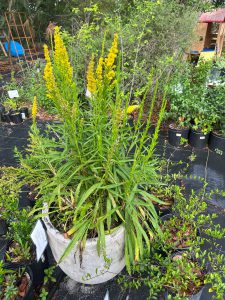
Many native plants adapt very well to container environments; in fact, shrubs, palms, or small trees can thrive for years in container pots. In addition, wildflowers produce seeds from which new plants will grow.
You can create a “mini” native habitat with a diversity of plants, including shrubs/small trees, ground covers that spill over their containers, vines and wildflowers! These container-grown plants will add beauty and interest to your garden space, and – best of all – provide shelter for small birds, nectar for visiting native pollinators, and host plants for butterflies!
WHERE TO START:
The following list is just a small sampling of native plants that are known to adapt well to container-growing. If you select one or two from each category, you’ll be well on your way to creating a beautiful and nature-filled mini-garden. Be sure to include evergreen species in your garden for year-round interest. Have fun experimenting with other native plants to grow in containers!
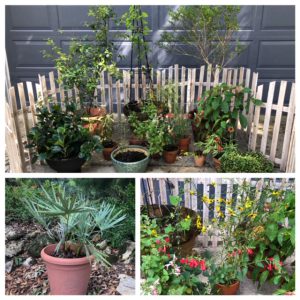
Trees/Large Shrubs: Simpson’s Stopper, Firebush, Sparkleberry, Walter’s Viburnum, Saw Palmetto
Smaller Shrubs/Grasses: Coontie Cycad, Pink Muhly Grass, Bahama Senna*
Vines: Pipevine*, Coral Honeysuckle, Corkystem Psssionvine*
Wildflowers: Gaillardia, Coccinea Sage, Coreopsis, Rosinweed, Goldenrod, Milkweed*
Ground Cover_: Frogfruit*, Wire Grass, native Pepperomia, Twinflower
(*indicates butterfly host plant)
TIPS ON GROWING NATIVE PLANTS IN CONTAINERS:
* Purchase your plants from a trusted source of native plants. For a list of native plant nurseries, visit fann.org. Some native nurseries are not open to the public, but many are; best to call before a visit.
* Begin by installing young plants in smaller containers, moving them to larger pots as their root system fills the pot. Aim to grow your plants in large containers — at least 14-16 inches – the larger the better, especially for woody shrubs or small trees (24”x24” or larger)! For smaller plants such as wildlflowers, you can group several in one large pot. The large containers will allow your plants’ roots to expand, supporting larger plants. Also, larger pots will need less supplemental watering.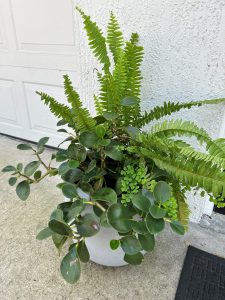
* Although native plants in the wild can thrive on rainfall alone, container plants will need supplemental water. Locate your plants near a water source (water spigot or rain barrel) to be hand-watered, as needed.
* If your space is very sunny, include larger plant species that can provide a bit of shade for smaller plants, such as wildflowers. While many wildflowers in nature thrive in sunny areas, when grown in containers they can benefit from dappled shade especially in hot afternoon sun.
* If you include butterfly host plants, it is a good idea to plant several of the same species in order to provide ample food sources for hungry caterpillars.
* For growing vines, go vertical! Insert a trellis or make your own (tall bamboo stakes with spiraling wire wrapped around).
* If you are interested in growing native milkweeds, be aware that growing native milkweed plants in containers can be tricky. Learn what native conditions support different native milkweed species, and experiment. Swamp milkweed species, such as incarnata or perennis, require wet conditions. They can be grown in containers that have no drain-holes in the bottom of pot. Drain-holes can be drilled about 3 inches from bottom of pot, so that standing water is avoided, but bottom soil remains damp to mimic their natural habitat.
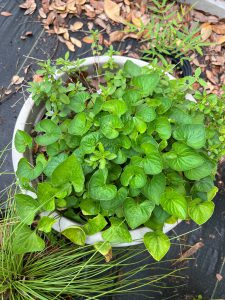
* Generally, native plants will need little to no supplemental fertilizer, but as nutrients are leached through containers, larger shrubs/trees may benefit from a springtime application of composted material or a slow release-type fertilizer, if needed.
* To support visiting wildlife, remember to include a source of water in your garden space, such as a bird bath. Remember to keep clean by replenishing with fresh water every other day or so, and scrub clean with a brush, as needed.
* To provide a safe environment for visiting wildlife, do not apply pesticides on or around your native plants. If your plant is not thriving, contact your local UF/IFAS Extension Plant Clinic for assistance.
Grow your own native plant garden – in containers – and enjoy a bit of Florida’s nature in your own corner of the world. Happy Gardening!
For more information, contact UF/IFAS Extension Polk County at (863) 519-1041 or visit us online at http://sfyl.ifas.ufl.edu/polk. The Plant Clinic is open Monday-Friday, 9:00 am-4:00 pm to answer your gardening and landscaping questions. Give us a call or email us at polkmg@ifas.ufl.edu.
If you are not in Polk County, Contact your local UF/IFAS Extension Master Gardener Volunteer Plant Clinic.
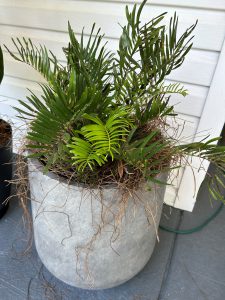
The Florida Master Gardener Volunteer Program is a volunteer-driven program that benefits UF/IFAS Extension and the citizens of Florida. The program extends the vision of the University of Florida/Institute of Food and Agricultural Sciences, all the while protecting and sustaining natural resources and environmental systems, enhancing the development of human resources, and improving the quality of human life through the development of knowledge in agricultural, human and natural resources and making that knowledge accessible.
This article was written by Master Gardener Volunteer Molly Griner under supervision of the Master Gardener Volunteer Coordinator and Residential Horticulture Extension Agent Anne Yasalonis.
An Equal Opportunity Institution.
 3
3
